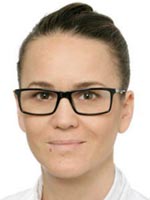There are different types of frozen shoulder. Pain is an accompanying symptom. The primary goal is cortisone treatment as therapy. However, if the joint does not respond to this treatment or is prone to relapse, surgery is an option. Here the joint capsule is cut open. After a few weeks, the joint is ideally free to move again. However, patients should exercise caution for a while during sports activities. First, the joint must be strengthened in physiotherapy and the stiffening prevented.
The therapy is often difficult and should be carried out by doctors who specialize in this disease, as in many cases a duary movement restriction and painfulness may remain.
Causes of the frozen shoulder
The frozen shoulder is usually a result of repeated unexplained irritation or inflammation of the synovial fluid. The problem takes place within the joint.
There are two types of frozen shoulder:
- Primary frozen shoulder:
- It begins with inflammation of the synovial mucosa and occurs primarily in women between the ages of 40 and 60. Since this is painful, those affected tend to protect the joint and move as little as possible. This preservation, added to the fact that the joint is inflamed, causes the joint capsule to shrink.
- The mobility of the joint is now restricted. The frozen shoulder can regress spontaneously. It usually runs in phases.
- A risk factor is sugar disease.
- Secondary frozen shoulder:
- The secondary frozen shoulder can result from a long immobilization of the joint (plaster, bandage), injuries, e.g. Shoulder dislocation, wear, or a calcific tendinitis or surgery arise. Inflammation can also be a trigger. Here, too, the joint capsule shrinks.
Frozen shoulder after surgery
One cause of frozen shoulder is that surgery has taken place in the shoulder area. This can be an operation to reduce symptoms in the case of shoulder tightness (impingement), arthrosis or torn tendons (rotator cuff rupture). A more common reason is surgery for an upper arm head fracture, for example after a fall.
After the operation, it is part of the follow-up treatment that the arm is first kept still and worn in an arm splint or bandage. Depending on the operation, this can be indicated between 3 and 6 weeks. The danger of immobilizing the arm is primarily the development of frozen shoulder. The lack of movement and stretching of the capsule and the ligaments in the shoulder leads to shrinkage and sticking in these.
It is therefore a central concern of the surgeon and the physiotherapist postoperatively that the arm is no longer worn in the bandage as is absolutely necessary. The early passive exercise of the arm by a physiotherapist enables the arm to be moved without affecting the result of the operation, but at the same time reducing the risk of frozen shoulder.
If the arm is not adequately exercised, the patient runs the risk of frozen shoulder. It is therefore important that patients perform regular and structured exercises for the arm in accordance with the instructions of the doctor or the physiotherapist.
In addition to surgery on the shoulder, frozen shoulder can also occur after surgery on and in the skull, in the abdomen or the thorax (chest). However, this is very rare and is not one of the more common complications in such operations. The frozen shoulder after breast operations, e.g. breast cancer has also been rarely described. In all of these operations, it is also true that good and regular exercises for the shoulder greatly reduce the risk of frozen shoulder.
The frozen shoulder typically runs in 3 phases:
- Phase 1: stiffening
- Phase 2: stiff
- Phase 2: dissolution
The untreated frozen shoulder lasts from 18 to 24 months, but in individual cases it can take significantly longer.
Frozen Shoulder Symptoms and diagnosis
The symptoms, as the name suggests, are a stiffness of the shoulder. The joint cannot be lifted beyond a certain point, since this requires the “reserve” of the joint capsule.
In a healthy shoulder, the joint capsule has a few reserve folds to guarantee that the arm is moved sideways upwards by as many degrees as possible (the so-called abduction). If this reserve of joint capsule tissue is missing due to the shrinkage of the latter, it can easily be explained that the mobility of the arm is restricted.
Treatment of Frozen Shoulder
There are numerous options for treating frozen shoulder. However, it may take some time to heal completely. Which treatment is most suitable also depends on the phase of the disease.
Pain therapy is carried out with so-called non-steroidal anti-inflammatory drugs (NSAIDs) such as ibuprofen and diclofenac. These can be taken as a tablet or applied directly to the shoulder as a gel or cream.
Cortisone therapy as a syringe or in tablet form serves to relieve pain and improve mobility in the shoulder joint.
Another option for treating pain is the so-called nerve block. To do this, the nerves that cause the pain in the shoulder are anesthetized by local anesthetics.
The flexibility in the shoulder joint is improved by stretching exercises. These should initially be carried out as part of physiotherapy and later also by the person concerned alone.
Alternative, but not proven, helpful treatment options include acupuncture, laser therapy, magnetic field therapy and homeopathy.
If conservative measures do not improve symptoms, surgery can help improve shoulder problems. The operation is then usually carried out by means of an articulation (arthroscopy).
Cortisone shock therapy (oral)
Cortisone shock therapy is used for frozen shoulder to relieve pain and improve mobility.
For this, cortisone is taken in tablet form for about 3 weeks.
The cortisone dose is initially high and then gradually reduced.
Cortisone tablets show relief from the symptoms, but are not suitable for long-term therapy because side effects such as osteoporosis can occur.
It is also important that the cortisone tablets are not discontinued on their own, but are slowly slipped out, as this can also cause severe side effects in the hormonal balance.
Cortisone injection
The cortisone syringe is placed directly in the joint and therefore acts directly on the shoulder joint.
The pain can be alleviated and mobility can be improved.
However, it should also be noted here that side effects can occur.
A cortisone injection should not be used too often, since in addition to the anti-inflammatory component, tissue shrinkage (atrophy) can occur with repeated use.
Furthermore, there is always a risk of infection in the case of a puncture.
Whether tablets or syringes are suitable should be discussed with the treating doctor regarding the advantages and disadvantages of the therapies.
Anti-inflammatory drugs
Anti-inflammatory drugs are so-called NSAIDs or non-steroidal anti-inflammatory drugs.
These pain relievers include ibuprofen and diclofenac.
They are used against the pain that occurs in the first and second phases of frozen shoulder.
It should be ensured that the pain reliever is taken early and then regularly to achieve the desired effect.
As the NSAIDs also attack the gastric mucosa, gastric protection should also be taken prophylactically during the time of ingestion.
Proton pump inhibitors such as pantoprazole are suitable for this.
NSAIDs can also be applied directly to the affected shoulder as a gel or cream.
Physiotherapy
Physiotherapy is used to promote mobility, especially in times of stiff shoulders.
The movement in the shoulder is only carried out by the physiotherapist, so the patient does not actively move the shoulder.
Physiotherapy gradually improves mobility in the shoulder.
Physiotherapy can take several weeks to complete freedom of movement in the shoulder joint.
Stretching exercises
Stretching exercises are an important part of therapy for frozen shoulder.
There are various exercises that can be carried out independently by those affected as part of physiotherapy.
The stretching exercises serve on the one hand to increase the flexibility in the joint.
On the other hand, they counteract a loss of muscles through immobilization.
When performing the exercises, care should be taken to ensure that there is no pain during stretching.
Which exercises are suitable and how they are carried out correctly should be discussed during physiotherapy.
When do you need an operation?
Surgery becomes necessary if conservative therapy does not improve frozen shoulder or pain cannot be adequately contained even during therapy.
It is important to perform physiotherapy even after surgery in order to maintain the flexibility in the shoulder joint achieved by the operation.
Even after surgery, there may still be limited range of motion and pain.
This is done in the operating room
During the operation, the joint capsule, which is stiffened and thus limits the mobility of the shoulder, is loosened and expanded.
In addition to manipulation under anesthesia (MUA), joint mirroring (arthroscopy) is often performed.
With MUA, the patient is anesthetized, so the muscles in the shoulder are relaxed.
The doctor then moves the shoulder in all directions to widen and loosen the joint capsule.
In the case of joint mirroring, instruments are inserted directly into the joint capsule via small skin incisions.
With these instruments, small parts of the joint capsule are incised in order to expand the capsule and increase the range of motion in the shoulder.
Manipulation and joint mirroring are often combined.
Forecast
The frozen shoulder can spontaneously recede by itself. After an operation, rehabilitation is necessary for a few weeks in order to slowly restore full mobility. Patients can also practice sport again, but should discuss their shoulder-stressing sport (tennis, etc.) with their doctor beforehand.
How long are you on sick leave?
If there is frozen shoulder, you do not have to be written sick or unable to work. However, if the patient does hard physical work or has to do work that requires regular and complex movement of the shoulder, then the doctor in charge must be discussed to what extent an incapacity to work can be attested or whether a temporary appointment in other areas of activity can be discussed with the employer can. Should the frozen shoulder have been operated on, the patient is usually written off for 3-4 weeks. Then, depending on the pain, it must be tested how quickly the patient can return to work.
Prophylaxis
As the cause of the capsule shrinkage or the inflammation has not been conclusively determined, no preventive measures can be recommended.
Inflammation of the shoulders cannot be prevented.
Duration
The frozen shoulder usually goes through three phases. Depending on the cause, form and type of treatment, frozen shoulder ideally disappears in between 9 and 18 months. If there are additional causes, such as arthrosis or defects on the rotator cuff, healing can be delayed. In the case of non-ideal courses, it can take several years until the frozen shoulder is completely cured.
The first phase, the initial or inflammatory phase, is characterized by pain that also occurs at night and lasts for about 9 to 12 months.
In the second phase, also known as the stiffening phase, patients complain of a loss of movement and are often no longer able to perform everyday tasks and movements. This phase can last between 4 and 12 months.
The last and third phase is known as the thawing phase and can last for several years in the worst case. It includes that shoulder mobility slowly returns. Good physiotherapy treatment is a key component here. There can be phases when things are going better or worse.
The complete course of the healing process can be very different individually. Good cooperation with the doctor and the physiotherapist is therefore important here.

























 Loading ...
Loading ...


